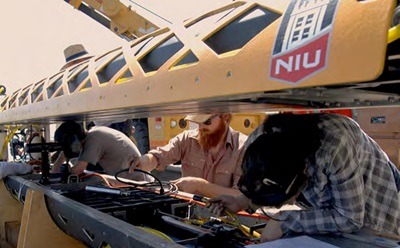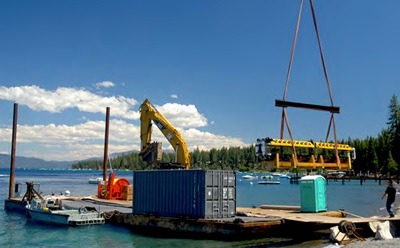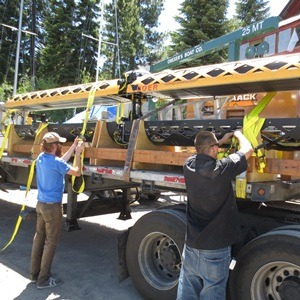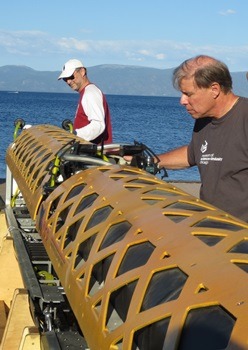
NIU Ph.D. student Tim Hodson works with DOER engineers preparing the robotic submarine instrumentation for testing.
Northern Illinois University’s 28-foot-long, 2,200-pound robotic submarine, built for exploration beneath the ice shelf in the Antarctic, is getting its maiden voyage this week in one of the nation’s deepest and most celebrated bodies of water—Lake Tahoe.
The unmanned yellow submarine—also known as a remotely operated vehicle (ROV) or sub-ice rover (SIR)—is equipped with a high definition camera and a suite of scientific instrumentation. It will be assessed by a team of scientists and engineers from NIU’s Department of Geology and Environmental Geosciences and DOER Marine, a robotics engineering firm located in the San Francisco Bay area.
DOER built the ROV for NIU, which intends to use the vehicle to study melting beneath the Ross Ice Shelf in Antarctica.
“This is a one-of-a-kind remotely operated vehicle that has been years in the making, so we’re excited to finally see it in action,” said Ross Powell, an NIU Board of Trustees geology professor. “Not only will we be testing the instrumentation during a series of dives this week, but we’ll also be using the vehicle to gather images of an earthquake fault at the lake bottom.”
Investigating West Tahoe Fault
The submarine will investigate the West Tahoe Fault, located on the lake floor along its entire western shore.
Scientists from the California Geological Survey and California Seismic Safety Commission, which provided $75,000 in funding for the dives, hope to gain more information about the fault to better assess the hazard of potential earthquakes, landslides and tsunamis.
“The goal is to capture the first-ever high definition images and subsurface sediment profiles of the fault,” said Gordon Seitz of the California Geological Survey.
Like most of the western United States, the Lake Tahoe region is tectonically active and subject to earthquake shaking. The existence of the extremely deep lake adds an additional earthquake-induced tsunami hazard, according to Seitz, who is an expert on the history of earthquakes and faulting in the Lake Tahoe Basin.
He said the West Tahoe Fault is the most active of three major faults in the lake. Although it has not generated a tremor in historic times, the fault is believed to produce large earthquakes every 2,000 to 4,000 years.
A crane atop a barge will be used to lower the unmanned submarine into the lake. The vehicle will be tethered to an on-deck control room with multiple video monitors, providing real-time data.
Seitz has targeted the most active portion of the West Tahoe fault, a six-mile long stretch at water depths of about 900 to 1,200 feet. “This portion of the fault has never been observed,” he said.
Underwater ‘transformer’
The sub-ice rover, which is rated for a depth of nearly 5,000 feet, is built specifically for Antarctic science, however. Most notably, while the vehicle is 28 feet in length, it can collapse to a width of just 22 inches in diameter.
This is a necessary feature, because the submarine must be slim enough to fit into a 30-inch-wide ice borehole. It will be lowered through a half mile of ice into ocean water beneath the Ross Ice Shelf—a floating slab of ice the size of France. About two miles of cable will tether the submarine to a control center on the ice, where images and data will be collected.
“Once under the ice, the robotic submarine undergoes a Transformer-like change in its shape as it prepares for ‘flight mode’ in the seawater,” said Reed Scherer, an NIU Board of Trustees professor of geology. “It’s an impressive piece of technology that should produce some amazing science.”
Up close look at hidden corner of planet
The Antarctic project is currently in development stages. The hope is that the sub-ice rover will enable scientists to investigate some of the last unexplored aquatic environments on the planet.
One key objective will be to observe melting and other conditions at the interface between seawater and the base of the glacial ice. The submarine also will investigate the sea floor and layers of sediment beneath.
Up to now, all scientists know about conditions at the base of the ice is from theory and remote data from surface instruments. The submarine will provide scientists with images of the environment and physical, chemical and biological measurements of the ice, water and sediment conditions.
The information that will be gathered is critical to climate modelers trying to project potential future rises in global sea levels resulting from climate change. Substantial melting at the base of the ice shelf and ice sheet would lead to a more rapid sea-level rise.
Powell and NIU colleagues previously received funding from the National Oceanic and Atmospheric Administration for design and construction of the robotic submarine. Additionally, the Gordon and Betty Moore Foundation, based in San Francisco, contributed $1.3 million for the robotic submarine’s instrumentation and testing. Funding from the National Science Foundation for deployment in Antarctica is pending.
More information, photographs and video from the Lake Tahoe test run are available online.



